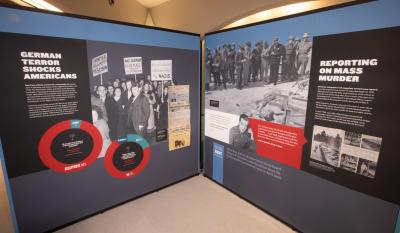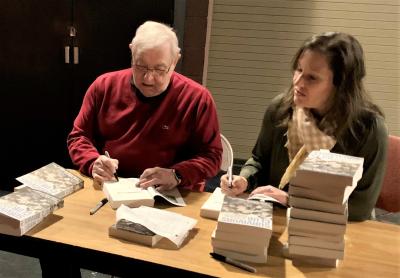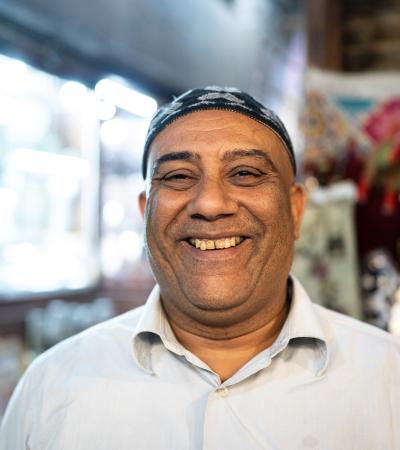After seeing all the poignant imagery that is part of the Americans and the Holocaust traveling exhibition, Joa LaVille had the strongest emotional reaction to … a pie chart. LaVille, youth services manager at the Marshalltown Public Library in Iowa, which received a grant to display the exhibition in 2022, was struck by a graphic illustrating the results of a 1938 public opinion poll.

According to the poll, 94 percent of Americans said they disapproved of the Nazi treatment of Jews in Germany, yet 71 percent said they didn’t want more Jewish refugees to immigrate to the United States. Why such a gap between disapproval and willingness to act?
“It’s one of the most haunting parts of the exhibit,” LaVille says. “This is the part that kept me up at night. I realized it’s about how Americans’ attitude toward immigration informed their beliefs about the Holocaust.”
The 1,100-square-foot exhibition, which includes text panels and some multimedia elements, examines the U.S. response to Nazism, war and genocide in Europe during the 1930s and 1940s, and challenges visitors to question not only how they might have responded in the past (“What would I have done?”) but also in the present (“What will I do?”).
When the Marshalltown Library exhibition ended after six weeks, residents had at least one answer to what they “will do.”
Mike Ladehoff, a city council member who toured the exhibition, was so moved by what he saw that he led a community effort to bring a family fleeing the current war in Ukraine to Marshalltown. In September 2022, the Myroshnikov family of Mariupol, Ukraine — Maria and Philip, their children Anhelina, Damir and Karim, and Maria’s mother, Katerina — settled into a farmhouse in Marshall County.
The special library exhibition, presented by the United States Holocaust Memorial Museum and the ALA Public Programs Office — based on the exhibition at the Museum in Washington, D.C. — will travel to 50 U.S. public and academic libraries from 2021 to 2023, and the tour has been extended. 50 more libraries will host it from 2024 to 2026. If your library is interested in hosting the exhibit, apply by October 14, 2023.
Participating libraries must present free public programs in conjunction with the exhibition, and the Marshalltown Library’s efforts were beyond successful. During the exhibition’s run in Marshalltown, 10,000 people from 31 states and Mexico ended up visiting the exhibit or participating in programming.
“Personally and professionally, this is the most important work I’ve done in 38 years of being a librarian,” says Sarah Rosenblum, Marshalltown Library director.
LaVille and Rosenblum worked closely with community partners — including K-12 schools, state colleges and universities, Jewish organizations, historical societies, synagogues and churches, the chamber of commerce, and local clubs — to plan related programs for students and adults. They wanted to make the exhibition and the topics it explores as relevant as possible to the residents of their town and state. Marshalltown, a city of about 27,000 in the middle of Iowa, has a population that is “surprisingly diverse” for the state, LaVille says: about 30 percent Hispanic, with immigrants from Mexico, Guatemala, and Honduras, as well as recent refugees from Myanmar. Rosenblum, who identifies as a secular Jew, says the town doesn’t have a large Jewish population but does have a veterans’ home and a population of people, young and old, interested in history.
LaVille and Rosenblum shared some of their most successful programming ideas, and how they made events and activities meaningful and appropriate for their community and different age groups. They used books, resources and suggestions from the ALA and the Museum and also came up with their own ideas.
Host a talk by a Holocaust survivor

The most widely attended event — with 750 people in the audience, at the Marshalltown Performing Arts Center — was a talk by Holocaust survivor Michael Bornstein and his daughter, journalist Debbie Bornstein Holinstat. Originally from Zarki, Poland, Bornstein was 4 years old when Soviet soldiers carried him out of Auschwitz in 1945 — one of the youngest prisoners liberated that day. Bornstein, a retired scientist who earned a Ph.D. from the University of Iowa, and his daughter wrote “Survivors Club: The True Story of a Very Young Prisoner of Auschwitz,” a book geared toward teen readers but equally meaningful to adults.
The audience was riveted during their talk, Rosenblum says. “When Michael rolled up his sleeve and showed the number tattooed on his arm, there was not a dry eye in the place. I think the Holocaust is so overwhelmingly horrible that it’s hard for people to take it in, and we’re kind of in a bubble here, so being able to bring a survivor’s voice to our community was an incredible experience.”
Connect the exhibition to local history
Before the Americans and the Holocaust traveling exhibition even arrived, the library presented an educational program on prisoner-of-war camps in Iowa for German and Japanese soldiers in the 1940s. The prisoners at the camp came to Marshalltown to work in a canning factory. Then, while the exhibition was on display, Jeremy Best, Ph.D., a professor of history at Iowa State University, presented a talk at the library titled “Hawkeyes and the Holocaust: What Did Iowans Know?” He discussed how and when information about the Holocaust reached Iowa, and how Iowans responded (or didn’t) to the news.
“People think Iowans didn’t know at the time, but Best shared newspapers that were chock-full of facts and reporting on things happening,” Rosenblum says. Some people who attended the program recalled hearing their parents talk about World War II and the Holocaust when they were 5 or 6 years old, Rosenblum says.
LaVille, who spoke to Spanish-speaking immigrants about the exhibition, wanted to explore the history of immigration to the U.S. around 1917-18, when the exhibition’s timeline starts. She also talked about immigration issues today and shared current newspaper editorials, along with stories about more recent refugees who, like Jews in the 1930s and 1940s, experienced bureaucratic challenges in their attempts to immigrate. “The idea I was going for is what Martin Luther King Jr. said: ‘Injustice anywhere is a threat to justice everywhere,’” says LaVille.
Highlight ‘helpers’ — for both youth and adult audiences
As LaVille planned exhibition-related programs for local students in grades 6-12 in partnership with local schools, she wanted to help them understand the Holocaust at an age-appropriate level.
For the youngest students, sixth-graders who visit the library monthly, “maybe four kids out of 350 had heard the term Holocaust,” she says. “I had to use concepts they are familiar with.” She used books to introduce helpers and heroes, such as Jennifer Roy’s “Jars of Hope: How One Woman Helped Save 2,500 Children During the Holocaust.”
For adults, the library screened the 2013 HBO documentary “50 Children: The Rescue Mission of Mr. and Mrs. Kraus,” about Gilbert and Eleanor Kraus of Philadelphia, a Jewish couple who went to Germany in 1939 to help save Jewish children in Vienna from the Holocaust by providing homes for them back in the U.S. Steven Pressman, the film’s producer and director, who also wrote a book about the Krauses, gave a talk at the library and signed books.
“People had a lot of questions about antisemitism,” Rosenblum says, including uncertainty about whether it still exists, and what the word actually means. In response, t he library presented a talk pre-recorded by the Museum titled “Antisemitism: Here and Now” by Deborah Lipstadt, then a professor of history. Ambassador Lipstadt, now the U.S. Special Envoy to Monitor and Combat Antisemitism, was depicted in the 2016 movie “Denial,” which is based on her book “History on Trial: My Day in Court with a Holocaust Denier.” In the talk, she explained the origins of the word “antisemitism,” the harmful anti-Jewish stereotypes that have existed for centuries, and the importance of combating antisemitism today.
LaVille, who led many visitors through the exhibition, said she liked focusing on “the helpers, the heroes, because I’m a strong believer that all of us can do something; it doesn’t need to look the same for each person. You can protest, write letters, provide direct service, donate money, use a position of privilege to help. You don’t have to wonder what you would have done at that time. You can be different now.”
Both LaVille and Rosenblum appreciated that the exhibition asks questions, but doesn’t necessarily provide answers.
“All the exhibition panels are questions,” LaVille says. “This wasn’t a finite event that happened; it’s continuing to have an impact. That’s what we wanted people to understand.”

